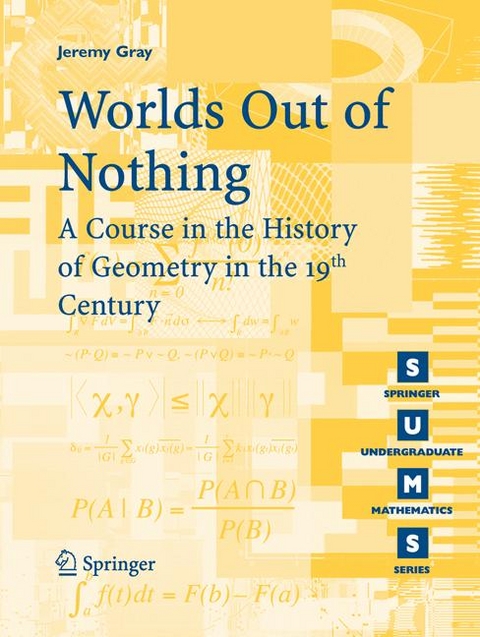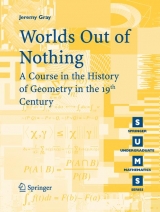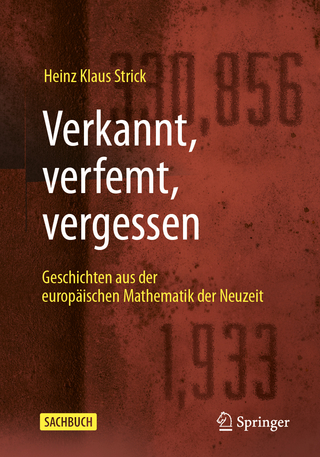Worlds Out of Nothing
A Course in the History of Geometry in the 19th Century
Seiten
2006
|
Edition. ed.
Springer London Ltd (Verlag)
978-1-84628-632-2 (ISBN)
Springer London Ltd (Verlag)
978-1-84628-632-2 (ISBN)
- Titel erscheint in neuer Auflage
- Artikel merken
Zu diesem Artikel existiert eine Nachauflage
Presenting the history of geometry in the 19th century, this book provides an overview of the growth of mathematics and offers guidance on the teaching of the history of mathematics. It considers how projective geometry rose to prominence, and looks at Poincare's ideas about non-Euclidean geometry and their physical and philosophical significance.
Based on the latest historical research, "Worlds out of Nothing" is the first book to provide a course on the history of geometry in the 19th Century. Topics covered in the first part of the book are projective geometry, especially the concept of duality, and non-Euclidean geometry. The book then moves on to the study of the singular points of algebraic curves (Plucker's equations) and their role in resolving a paradox in the theory of duality; to Riemann's work on differential geometry; and to Beltrami's role in successfully establishing non-Euclidean geometry as a rigorous mathematical subject. The final part of the book considers how projective geometry rose to prominence, and looks at Poincare's ideas about non-Euclidean geometry and their physical and philosophical significance. Three chapters are devoted to writing and assessing work in the history of mathematics, with examples of sample questions in the subject, advice on how to write essays, and comments on what instructors should be looking for.
Based on the latest historical research, "Worlds out of Nothing" is the first book to provide a course on the history of geometry in the 19th Century. Topics covered in the first part of the book are projective geometry, especially the concept of duality, and non-Euclidean geometry. The book then moves on to the study of the singular points of algebraic curves (Plucker's equations) and their role in resolving a paradox in the theory of duality; to Riemann's work on differential geometry; and to Beltrami's role in successfully establishing non-Euclidean geometry as a rigorous mathematical subject. The final part of the book considers how projective geometry rose to prominence, and looks at Poincare's ideas about non-Euclidean geometry and their physical and philosophical significance. Three chapters are devoted to writing and assessing work in the history of mathematics, with examples of sample questions in the subject, advice on how to write essays, and comments on what instructors should be looking for.
Mathematics in the French Revolution.- Poncelet (and Pole and Polar).- Theorems in Projective Geometry.- Poncelet's Traite.- Duality and the Duality Controversy.- Poncelet and Chasles.- Lambert and Legendre.- Gauss.- Janos Bolyai.- Lobachevskii.- To 1855.- Writing.- Mobius.- The Duality Paradox.- The Plucker Formulae.- Higher Plane Curves.- Complex Curves.- Riemann.- Differential Geometry of Surfaces.- Non-Euclidean Geometry Accepted.- Writing.- Fundamental Geometry.- Hilbert.- Italian Foundations.- The Disc Model.- The Geometry of Space.- Summary: Geometry to 1900.- The Formal Side.- The Physical Side.- Is Geometry True?- Writing.- Appendix: Von Staudt and his Influence.- Bibliography.- Index.
| Erscheint lt. Verlag | 13.12.2006 |
|---|---|
| Reihe/Serie | Springer Undergraduate Mathematics Series |
| Zusatzinfo | 68 black & white illustrations |
| Verlagsort | England |
| Sprache | englisch |
| Maße | 178 x 235 mm |
| Gewicht | 749 g |
| Einbandart | Paperback |
| Themenwelt | Mathematik / Informatik ► Mathematik ► Allgemeines / Lexika |
| Mathematik / Informatik ► Mathematik ► Geometrie / Topologie | |
| Mathematik / Informatik ► Mathematik ► Geschichte der Mathematik | |
| ISBN-10 | 1-84628-632-8 / 1846286328 |
| ISBN-13 | 978-1-84628-632-2 / 9781846286322 |
| Zustand | Neuware |
| Informationen gemäß Produktsicherheitsverordnung (GPSR) | |
| Haben Sie eine Frage zum Produkt? |
Mehr entdecken
aus dem Bereich
aus dem Bereich
Buch | Hardcover (2023)
Hanser, Carl (Verlag)
CHF 41,95
Geschichten aus der europäischen Mathematik der Neuzeit
Buch | Softcover (2024)
Springer (Verlag)
CHF 41,95





